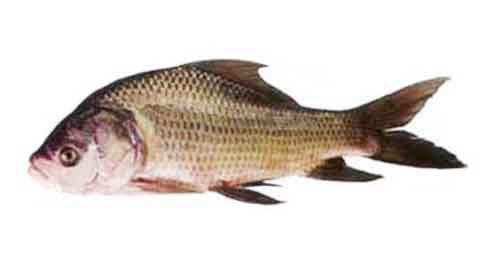Freshwater fish live in freshwater habitats such as rivers, lakes, streams, ponds, ditches, marshes, flood plain, etc. About 41.24% of all known fish species occur in freshwater. The most notable freshwater fish species are Rohu, Catla, Mrigal, etc. In this article, we will discuss about the Catla calta and its life history.
Systematic Position
- Phylum: Chordata
- Sub phylum: Vertebrata
- Class: Actinopterygii
- Order: Cypriniformes
- Family: Cyprinidae
- Sub family: Cyprininae
- Genus: Catla
- Species:Catla catla Hamilton,1822
Synonyms
Cyprinus catla Hamilton, 1822; Catla catla (Hamilton, 1822); Catla buchanani: Day, 1878; Leuciscus catla (Hamilton, 1822); Cyprinus abramioides Sykes, 1839; Hypselobarbus abramioides (Sykes, 1839); Catla catla Shaw and Shebbeare, 1937;
Fin Formula
D. 17-18(2/15-16); P1. 18-20; P2. 9; A.8 ( 3/5) (Rahman, 2005)
Physical Description
Catla is a well-known fish of the Family Cyprinidae under the order Cypriniformes. This fish is very wide in proportion to its body length, its head and mouth are quite large. The space between the eyes is slightly convex. Two pairs of nostrils present. Each pair is located at the top of the front of the eye.
The mouth and pharynx are wide. The maximum depth of the body is in front of the dorsal fin. They have no barbells. The lateral line organ is complete. There are 40-43 scales along this line. The dorsal fin is long. The pectoral fin does not reach the pelvic fins but the pelvic extends to the anal fin. The caudal fin is deeply bifurcated.
There are big size scales in the body. The surface of the body is gray, the sides of the body are silver and the abdomen is white. The fins are also black, but the pectoral fins are much whiter. The number of their branchiostegal rays is III. There are usually 17-18 soft rays in the dorsal fin, 18-20 in the pectoral fins, 9 in the pelvic fins, 8 in the anal fins and 19-20 in the tail fins.
This fish is fast-growing and can grow up to four kg in one year and ten kg in two years if it gets sufficient food. The maximum length of Catla fish can be up to 1.80 m. Catla fish can weigh up to a maximum of 45-50 kg.
Habit and habitat
The mouth of the Catla fish is slightly upward. They feed on the surface of the water. Apart from that, they are accustomed to pick and eat small food particles. They cannot take any food from the bottom and they cannot afford to eat aquatic weeds.
Catla eats more phytoplankton than zooplankton. They eat the most food from 8-9 am (Jana and Chakrabarti, 1988). However, according to Shafi and Quddus (2001), there is still a tendency to eat from noon to evening. Four-day-old fry eats Brachionus spp., Ceriodaphnia spp. and Moina spp. Etc, (Chakrabarti and Sharma, 1997; Kumar and Chakrabarti, 1998; Kumar et al., 2000).
Large-sized Catla prefers to eat plankton both Phytoplankton and zooplankton (Natarajan and Jhingran, 1961; Jhingran, 1991). They also eat aquatic insects, rotting garbage, algae, and aquatic plants. When cultivating in the pond, fish meal, mustard oil cake, rice corn, etc. are taken as a supplementary food.
Catla fish live in major rivers of Bangladesh including Buriganga, Meghna, Beel, Haor, and Baor (Oxbow lake). It is also seen in paddy fields during monsoon. They can also live in stagnant waters. They are also found in large numbers in India, Pakistan, and Myanmar.
Table: Percentage of food intake at different stages of life of Catla catla
| Food types | Fingerlings | Juveniles | Adults |
|---|---|---|---|
| Algae | <11.2 | 19.8 | 27.3 |
| Detritus | <5.6 | 17.2 | 26.8 |
| Invertebrates | <5.9 | 57.3 | 39.5 |
| Aquatic plants | – | 5.9 | 6.4 |
Data source: (1) Mohanty (2003); (2) Natarajan and Jhingran (1961)
Reproduction
Catla fish usually breed at the age of 3-5 years. They usually lay eggs in May-June. They do not lay eggs in stagnant water, but they lay eggs in relatively shallow water and in flowing rivers. An adult fish can lay 1.5-2.0 lac eggs. The eggs are neither floating nor sticky. Eggs are light red in color with 4.5-5.4 mm in diameter.
Embryonic development of Catla catla
Segmentation begins 35-40 minutes after the fertilization of eggs. The diameter of a mature egg is 4.5-5.4 mm with averages of 5.0 mm in diameter (Figure-2). 2nd and 3rd cleavage occur every 10 minutes. Within 1 hour 45 minutes, it reaches the Morula stage. Yolk invasion is half done in 3 hours and reaches the yolk plug stage in 2 hours. In the next 30 minutes, the yolk plug stage becomes longer and the myotome is seen after 6 hours of fertilization. After that, the head and tail areas begin to separate.
When 17 myotomes are seen, the clusters of yolk spread up to the tail region. Kupffer`s vessels and auditory vessels are seen at this time. About 9 hours after fertilization of eggs, the fetus begins to vibrate gently. Egg hatching is completed within 15-16 hours.
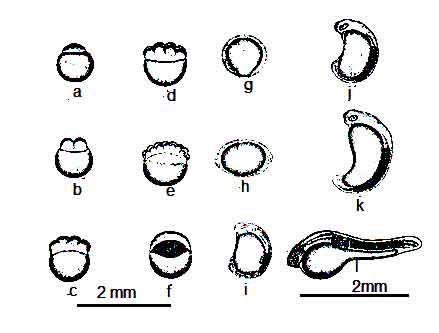
Figure:Embryonic development of Catla fish: fertilized egg- (a) newly formed bastodisk; (b) 2-cell phase; (c) 4-cell phases; (d) 8-cells phase; (e) 16-cells phase; (f) Morula phase; (g) Yolk plug phase, embryo; (h) Yolk plug elongation phase; (i) About 2 hours before hatching.
Table: Different stages of larval life of Catla
| Hatching | Hatching time (hours) | |||||
|---|---|---|---|---|---|---|
| 0 | 6 | 12 | 24 | 36 | 48 | |
| Average total length (mm) |
4.68 |
4.80 |
5.60 |
5.80 |
6.40 |
6.48 |
|
Range (mm) |
4.62-4.73 |
4.75-4.84 |
5.50-5.70 |
5.54-6.16 |
6.21-6.58 |
6.18-6.63 |
|
Length of the yolk sac(mm) |
3.06 |
3.14 |
3.20 |
2.72 |
2.90 |
3.06 |
|
Maximum length of yolk sac(mm) |
0.99 |
0.86 |
0.83 |
0.80 |
0.55 |
0.36 |
|
Body depth along the dorsal fin (mm) |
0.99 |
1.00 |
1.30 |
1.16 |
1.30 |
1.08 |
|
Number of pre-anal myotome |
26 |
26 |
2626 |
26 |
26 |
26 |
|
Number of post-anal myotome |
12 |
12 |
12 |
12 |
12 |
12 |
|
Eye diameter (mm) |
0.20 |
0.20 |
0.30 |
0.30 |
0.35 |
0.36 |
|
Eye color |
Colorless |
About colorless |
The center is black |
black |
Dark black |
Dark black |
|
Length to the rear end of the notochord (mm) |
4.60 |
4.70 |
5.40 |
5.68 |
6.12 |
6.25 |
|
The direction of movement |
Irregular movements can be noticed. Rarely rising up in a twisted position or resting laterally at the bottom. |
The movement is weak, resting laterally at the bottom of the habitat, rarely coming to the surface. |
Moves vertically, occasionally rising obliquely upwards. |
Moves slowly by shaking, sometimes move horizontally |
Moves slowly by shaking, sometimes move horizontally |
Cell |
|
Pectoral fin |
Absent |
Absent |
Absent |
Buds may be seen |
Present |
Present |
Larval development of Catla catla
Hatchling
The bulbous and slender parts of the yolk are of equal lengths, like a Mrigel fish. The eyes are obvious. No chromatophore was observed.
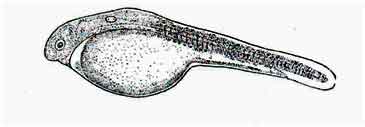
Fig. Hatchling of Catla
6th hours after hatching
The movement of the hatchling is very feeble. They rest on the side of the dwelling and rarely come to the surface. The eyes are colorless in most cases.
12nd hours after hatching
The body color is yellowish on the dorsal side above the yolk sac. Buds are not seen on the pectoral fins.

Fig. Larva of Catla catla: 12nd hours after hatching
24th Hours After Hatching
Buds can be seen on the pectoral fins. The movement of the larvae is fast. They begin to vibrate horizontally. They rest on the side of the dwelling. Black chromatophores exist on the upper edge of the yolk sac. There is more pigment in the eyes than on the edges of the eye. The tail fins are of the spatulate type. Spots can be seen on the fins. The narrow edges of the yolk, gradually become ribbons like shape. The position of the mouth is seen just like a small hole. Such pores are also seen in Mrigel fish.

Fig. Larva of Catla catla: 24th hours after hatching
36th Hours After Hatching
The dorsal part of the embryo is yellow. A few black chromatophores are seen on the dorsal side of the posterior myotome and yolk sac. However, there is no chromatophore above the head. The tip of the notochord is slightly curved upwards.

Fig. Larva of Catla catla: 36th hours after hatching
48th Hours After Hatching
The dorsal part of the embryo is yellow, the rest is dark yellow. There is a groove on the yolk on which a swimbladder is present and it is covered by black chromatophore. The front of the yolk is not concave. Rows of black chromatophores precisely begin from the auditory sensory part of the tail region. The embryonic dorsal fins fold begin from just behind the pelvic fins. The pectoral fins are distinct and they are like paddles.

Fig. Larva of Catla catla: 48th hours after hatching
72nd Hours After Hatching
At this time the larvae are 7.3 mm long. The larvae are externally bright yellow in color and the head region is dark green in color. The eyes are apparent (Figure 9A). The operculum or gill cover area has a reddish spot.
A series of black chromatophores are seen behind the eyes that extend from the pelvic region to the caudal peduncle. At this time, chromatophores are distinct up to the anus. Black chromatophores exist in a triangular region above the caudal peduncle below the notochord. Embryonic pelvic and dorsal fin folds exist. Yellow pigment is present on the dorsal side of the notochord at the caudal peduncle region.

Fig. Larva of Catla catla: 72nd hours after hatching
Pos-larval development of Catla catla
96th Hours or 4 Days After Hatching
At this time the larvae are 7.56 mm long. The edges of the lips are thick. The yolk sac is completely absorbed. There is a reddish spot all around eyes with a dark black center. A reddish color spot is seen on the anal vertebrae. The dorsal fin is separated from the embryonic fold

Fig. Post larva of Catla catla: 96th hours after hatching
5th Days After Hatching
The length of the fish is 9 mm. Dorsal and ventral embryonic folds are present and do not contain chromatophores. The anterior part of the dorsal fins fold has 6 fins rays. The caudal fins have 18 distinct fin rays. The notochord bends sharply upwards. The margins of the rays become branched rays, but no such condition is observed at the edges.
Black chromatophores are more widespread on the body than at the edges of the body. However, the pigmentation under the notochord of the caudal region in Catla is more pronounced. There are two crescent-shaped black chromatophores at the beginning of the origin of the caudal fin rays. The lower lip is slightly thicker and is located below the upper lip.

Fig. Post larva of Catla catla: 5th days after hatching
6th Days After Hatching
At this time the length of the fish is 11 mm. Buds exist in pelvic fins. The dorsal fin contains 11 rays. The swimbladder is divided into two parts. The anterior part is reddish and the posterior part is long. Pigmentation can be observed in the part of the caudal peduncle from which the rays have started to be generated. The caudal fin contains 20 fin rays. The ratio between the total length and the length of the base of the dorsal fin is 5.4: 1.

Fig. Post larva of Catla catla: 6th days after hatching
7th Days After Hatching
The length of the fish is 12 mm. The dorsal fin has 14 rays. The embryonic fins fold reaches up to the tail region. Pelvic embryonic fins fold exists. The caudal fin of the Catla is more forked than the mrigel fish. It is colorless but orange pigmentation can be noticed in some places on the dorsal part of the fins.
Behind the notochord, there are two unclear crescent-shaped regions which are formed by black chromatophores. The number of caudal fin rays is 22. The ratio of the total length and the length of the base of the dorsal fin is 5: 1.
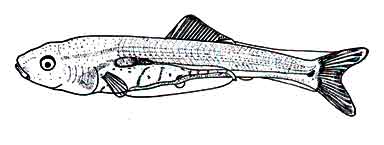
Fig. Post larva of Catla catla: 7th days after hatching
8th Days After Hatching
The length of the fish is 12.5 mm. At this time 15 fin rays are seen on the dorsal fin. The margin of the dorsal fins is not black like mrigal fish. The anal fins are connected by 7 rays. There is no chromatophore at the membranous junction of the caudal peduncle and the caudal fin.
The caudal fin contains 24 fin rays. At the base of the caudal fin, there is a dull yellow pigment. There are no fin rays in the pelvic fins. The ratio between the total length and the length of the base of the dorsal fin is 3: 1.
10th Days After Hatching
The length of the fish is 16.5 mm. The position of the mouth is like that of an adult fish. The body is golden yellow. There is no barbell. The rear tip of the notochord is sharply curved upwards. There is a thin embryonic fins fold that starts from the tip of the pelvic fin and ends at the anal fin.
There are 17 fin rays in the dorsal fin. Up to the last 4 rays of the dorsal fin, black chromatophores are seen along the edges of the fins. Half of the base of the fin rays is covered by yellow pigment. There are 8 rays in the anal fins and 30 rays in the caudal fin. Black spots of two specific chromatophores exist in the caudal peduncle. The front margins of all these spots are somewhat concave. The chromatophores form a black triangular structure below sharply curved notochords. This structure is more or less noticeable from the marginal area.
Pelvic fin contains 9 specific fin rays. The rays of the pectoral fins are less clear. Chromatophores are widespread throughout the light yellow colored body. There is a star-shaped black chromatophore above the head. The ratio of the total length and the length of the base of the dorsal fin is 5:1.

Fig. Post larva of Catla catla: 10th days after hatching
12nd Days After Hatching
The length of the fish is 19 mm. The dorsal fins have 19 fin rays. A line of black chromatophores can be seen in the anterior margin of the dorsal fin. 8 rays can be noticed in the anal fins. Except for the first two rays of the anal fin, the others are branched. The membrane is present between the pelvic and anal region. The ventral region is transparent but has no yellow pigment. However, small black spots of pigment are spread on it.
Pelvic fin contains 9 fins ray. The pectoral fins do not contain any chromatophores. The caudal fin contains 32 fin rays. The pigment is centered on the caudal peduncle to form a triangular structure with two crescent-shaped black chromatophores. There is no ray in the membranous part of the caudal fin and this part is covered by black chromatophore.
The dorsal fin membrane is covered by yellow pigment. The caudal fin rays are covered by yellow pigment. The dorsal part of the body with dark black chromatophores is light yellow. The ratio of total length and the length of the base of the dorsal fin is 5: 1.
15th Days After Hatching
The length of the fish is 23 mm. The dorsal fins have 19 fin rays, of which the first three fin rays are unbranched. The apex of the dorsal fin is covered by yellow pigment. The entire edge of the fin rays looks black as it is covered by a completely black chromatophore. The anal fins have 6 rays, of which the first two fin rays are unbranched.
The pelvic fin contains 9 fin rays. The caudal fin has 32 rays, of which the dorsal and ventral margins of the first 7 fin rays are unbranched. There is a triangular region on the caudal peduncle with black chromatophores whose base region is transparent but the apex is not clear. Behind this region, there are two crescent-shaped black condensed areas at the origin of the caudal fin.
These crescent-shaped structures form black color by adding chromatophores. Black chromatophores are widespread throughout the body. The dorsal side of these chromatophores is yellow. The chromatophores of the head are black. The ventral region of the body contains a small number of chromatophores. The ratio of the total length and the length of the base of the dorsal fin is 5: 1.
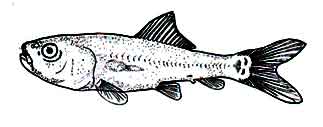
Fig. Post larva of Catla catla: 15th days after hatching
18th Days After Hatching
The length of the fish is 27 mm. The upper and ventral sides of the lateral line organ are not completely covered by rows of scales. When the length of the fish is 24 mm, the formation of scales begins. The formation of the first scales begins from the back of the operculum.
A distinctly crescent-shaped light black structure is present on each caudal fin lobe at the base of the caudal fins. These light black long markings are seen in the triangular area of the caudal peduncle. The chromatophores of these marks are equally wide.
20th Days After Hatching
The length of the fish is 28 mm. The operculum region of fish is red. The body is completely covered by scales. Black chromatophores can be seen in the lateral line. The upper part of the lateral line is dark yellow. The chromatophores above the lateral line are more numerous in numbers and darker in color. Yellow-orange pigment is scattered on the anal fins with 8 fin rays. In most cases, the anus exists in front of the anal fins.
On the top of the caudal peduncle, there is an incomplete light green triangular-shaped area. The tail fins are covered by light yellow-orange pigment. The triangular area on the caudal peduncle is covered by chromatophores. The edges of each of the 7 out of 34 fin rays of caudal fin are unbranched. The caudal peduncle is also covered by scales. The ratio between the total length and the length of the base of the dorsal fin is 5.7: 1.
25th Days After Hatching:
At this time the length of the fish is 30 mm. Body color is greenish yellow and operculum is reddish pink. The front edges of the eyes are light red. The edges of the upper lip are dark. The edges of the entire dorsal fin are deep and dark in color. The upper caudal fin lobe is slightly longer.
The dorsal fin has 3/16 rays. There is a black pigment in the form of a line at the edge of the fins, but it is not as obvious as the dorsal fins. The caudal fin ray is yellow. There are light dark diamond shaped regions are seen on the caudal peduncle.
Economic Importance of Catla catla
About 23-24% of the total fish production in Bangladesh comes from catla and other major carp. Catla fish accounts for 18% of the total pond production in Bangladesh. Each 100 grams of catla fish contains 16.4 grams of protein, 2.6 grams of fat, 514 milligrams of calcium and 214 milligrams of phosphorus. It also contains 563 IU of vitamin A.
References
Chakraborty, R.D. and Murty, R.S.V. 1972. Life history of Indian major carps, Cirrhina mrigala (Hamilton), Catla catla (Hamilton), and Labeo rohita(Hamilton). Journal of Indian Fisheries Society of India. 4:132-161.
Kabir, A.K.M. N. and Mia, Mohiuddin.2018. Fisheries Biology(in Bengali). 2nd edition. ATM Publications, 38/3, Banglabazar, Dhaka. pp. 623.
Rahman A. K. A. 2005.Freshwater Fishes of Bangladesh. 2nd edition. Zool. Soc. Bangladesh. pp. 394.
Shafi, M. and Quddus, M. M. A. 2003.Bangladeshher Matshya Sampad (in Bangali). Kabir Publications, 38/3, Banglabazar, Dhaka. pp. 345.

